A sample text widget
Etiam pulvinar consectetur dolor sed malesuada. Ut convallis
euismod dolor nec pretium. Nunc ut tristique massa.
Nam sodales mi vitae dolor ullamcorper et vulputate enim accumsan.
Morbi orci magna, tincidunt vitae molestie nec, molestie at mi. Nulla nulla lorem,
suscipit in posuere in, interdum non magna.
|
Article initialement publié sur Merlanfrit

Une licorne en moumoute fuchsia, un alien gonflable irisé, pêle-mêle des peluches de Mario, Kirby, et un bisounours. Des babioles qui brillent, colorées, roses, pimpantes, un tapis à franges qui dit « Player One Ready ». Une figurine de ballerine à côté d’une console de jeu NES. Une chambre de petite fille classique dans les années 90 ? Non, une installation de l’artiste Rachel Weil. Elle souhaitait mettre en scène ce qu’aurait pu être nos souvenirs d’enfance (à nous, les femmes) si les jeux vidéo avaient été « un truc de filles ». Cette chambre d’enfant à la fois « girly » et « geek » n’a probablement jamais existé pour personne.
Non, les jeux vidéo, c’était pour les garçons, qu’on le dise ouvertement ou pas. Dans mon cas, c’était même un truc un peu honteux pour les mauvais élèves. Probable que ça grillait les neurones, comme la télé. Je me souviens d’avoir joué à Pacman chez la copine de mon père divorcé. Elle avait un fils de mon âge, et je n’avais pas de frère. Il m’a fait découvrir mon premier « vrai » jeu vidéo – même s’il ne prêtait pas souvent la manette. Ça ressemblait effectivement à un truc de garçon, comme je le percevais avec ma vision sexiste de l’époque : pas très sophistiqué, basé sur les réflexes…
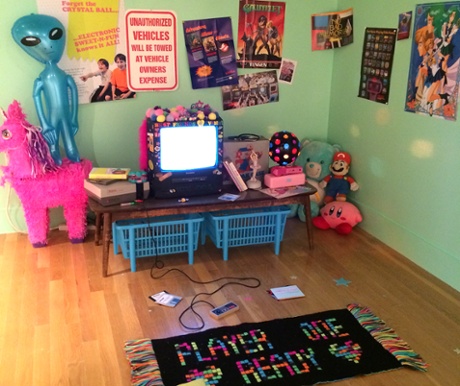
Dix ans plus tard, mon petit ami m’initiait à Super Mario. J’ai d’abord été surprise qu’il joue sans honte à quelque chose qui avait l’air fait pour les enfants, puis j’ai vite compris pourquoi. Là encore je n’osais pas trop jouer. Buter contre la même difficulté en boucle, gaspiller les powerups… J’avais peur de me ridiculiser et de prouver malgré moi que les filles ne sont pas douées pour ça. Ce n’est que bien plus tard, lorsque j’ai pu jouer seule, que je me suis fait un devoir – et une joie – de finir le jeu, jusqu’au bout. Pour me prouver que je pouvais y arriver.
Plus tard encore, un autre copain, d’autres jeux : il me fait découvrir Warcraft 2, Myst, Civilization 2, Age of Kings… Je poursuis l’exploration moi-même et je découvre The Longest Journey et cette héroïne qui me ressemble tellement, dans sa chambre d’étudiante dépouillée… Cette fois, je ne peux plus imaginer que le jeu vidéo ne fasse pas partie de ma vie.
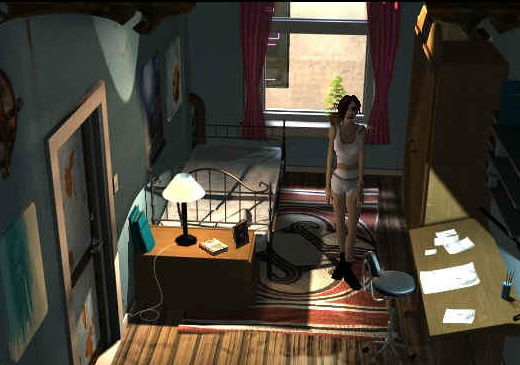
Quelques années passent et c’est encore avec un garçon que j’apprends à me servir d’outils comme Photoshop et bien d’autres, et grâce à qui je finirai par mettre un premier pied dans le développement de jeu. Presque dix ans après, c’est encore mon métier.
Mon parcours de fille et de femme n’était a priori pas fait pour que je croise le jeu vidéo. Malgré la mixité à l’école, bien des choses restaient cloisonnées. Il a fallu que je m’aventure dans une chambre de garçon pour découvrir ces choses un peu sulfureuses. C’est au contact de ces émissaires d’un autre monde que j’ai découvert le jeu vidéo et que j’ai pu m’approprier un petit bout de ce territoire, m’y installer, y apporter mes propres pierres. Et c’est cette mixité dont l’industrie a besoin maintenant.
Mon initiation n’est pas allée de soi. Je me souviens de l’époque où je ne supportais pas d’entendre les cris des unités mourantes dans Command & Conquer, ça me rendait malade. Aujourd’hui, même si je choisis toujours la voie « non-létale » quand elle est proposée, je ne lève même plus un sourcil face à toute l’hémoglobine qui barbouille l’écran de mes jeux préférés. Je me suis peu à peu désensibilisée à la violence virtuelle. Est-ce bien ou mal, ou indifférent, je ne sais pas. Mais je mesure le fossé culturel qui me sépare de mon moi passé quand j’essaie de montrer un jeu que j’aime à ma mère. Je lance The Last of Us, en me disant que l’intro où on joue une pré-ado, ça devrait bien passer. Je m’arrête soigneusement avant l’apparition du premier zombie. Mais c’est déjà trop, elle lâche juste un « Oh, ça fait peur quand même », d’un air embarrassé. J’ai eu plus de succès en montrant Caesar III à ma tante prof d’Histoire. Fascinée par la richesse de la simulation et la relative exactitude historique, elle se demandait déjà si elle pourrait le faire acheter par son collège et s’en servir comme outil pédagogique.
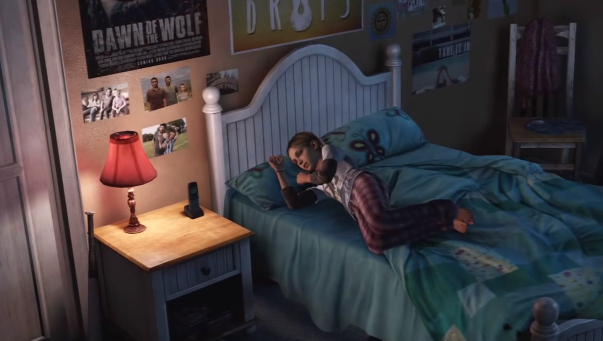
La légitimation du jeu vidéo comme objet de culture se fait petit à petit, et peut-être moins facilement quand ce n‘est pas quelque chose qui a toujours fait partie de son paysage personnel. Comme le faisait remarquer Elizabeth Sampat dans sa conférence à la GDC, 55% des femmes qui travaillent dans le jeu vidéo n’en avaient pas rêvé toute leur vie. A 10, 15 ou 20 ans, je ne rêvais pas d’en faire mon métier. Je n‘y avais même pas pensé. Il faut en finir avec le cliché que pour être développeur de jeu vidéo il faut avoir été prêt à s’ouvrir les veines par passion depuis sa première machine reçue un lointain matin de Noël.
Ça été quelque chose de complètement étranger que j’ai apprivoisé, avant que ça devienne une passion. Ça ne faisait pas partie de mon horizon des possibles. Mais maintenant chaque fois que je rencontre une nouvelle collègue, je me dis que c’est un peu d’horizon en plus pour d’autres petites filles. Comme cette collègue chez qui j’avais passé une nuit : sa fille m’avait prêté un t-shirt pour dormir, un t-shirt Assassin’s Creed que sa mère lui avait rapporté du boulot. Je crois que la gamine n’était pas vraiment joueuse, mais le jeu vidéo c’était « le boulot de Maman ». Ce n’était pas quelque chose de complètement étranger et impensable. Et j’avais dormi dans une chambre mauve, pleine de peluches et de bibelots qui brillent, avec un t-shirt à la gloire d’un assassin.
Les choses changent, assurément.
Merlanfrit se propose de faire un petit tour de ce nouvel horizon avec une série de portraits de développeuses de jeux vidéo : une théma au long cours, à suivre.
(Image d’en-tête : concept art de John Sweeney pour The Last of Us)
Can you see the difference between these two versions of the same scene?
The finger. It’s not the same finger that Aurora pricks on the spindle.
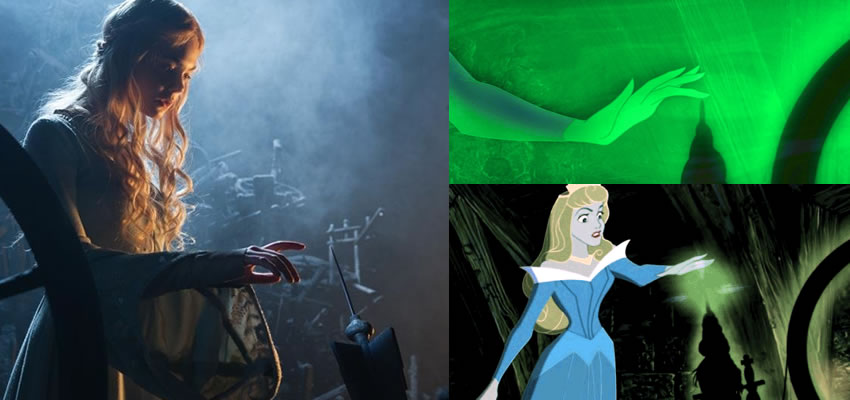
Like many tales, Sleeping Beauty was all about sex, and losing one’s virginity, and how you should be careful about that. The pointy spindle that pricks your finger and the blood running off, all of this happening when you turn 16 after meeting a handsome prince… the metaphor was obvious. And the old Disney even added this wonderful scene where Aurora dances with a fake prince (mimicked by forest animals) while singing a song about having wet dreams (this is what the song “Once upon a dream” is about, right? See below). A very cute way of talking about teenagers’ sexual awakening.
In Maleficent though, all of this has disappeared (spoilers ahead). Maleficent becomes the princess’ secret adoptive mother. Aurora doesn’t dream about boys, she seems like a little girl who spends her time giggling at fairies. The main twist of this version of the story shows that the Prince’s kiss is unable to wake her when she has fallen into her eternal sleep. It says that love at first sight does not exist (which may be seen as a progress from the Prince Charming trope, but I still find it depressing). And the only true love able to break the spell is the motherly love of the fairy godmother Maleficent for Aurora. An asexual love from a woman who has dedicated her life to seek revenge against her ex-lover, for a girl who dreams of living with this maternal figure forever in a land with no human beings.
I couldn’t shake a feeling of unease when I saw this new ending. I grew up with the Disney movie from 1959, I got the vinyl record for my birthday and dreamed I was Aurora for many years. There’s a lot to say about the image of womanhood it conveys, but at least I felt that it told me it was okay to be in love and to feel desire for a man and fantasize about him. It told me that we’re all born with gifts from good and bad fairies: desires to be wise and kind, but also desires for the unknown and forbidden. In the end, we all want to prick our finger on a pointy spindle.
So when I saw Maleficent, it really struck me that Aurora was pointing the wrong finger to the spindle. The index finger, instead of the middle finger. Come on, we all got the symbol.
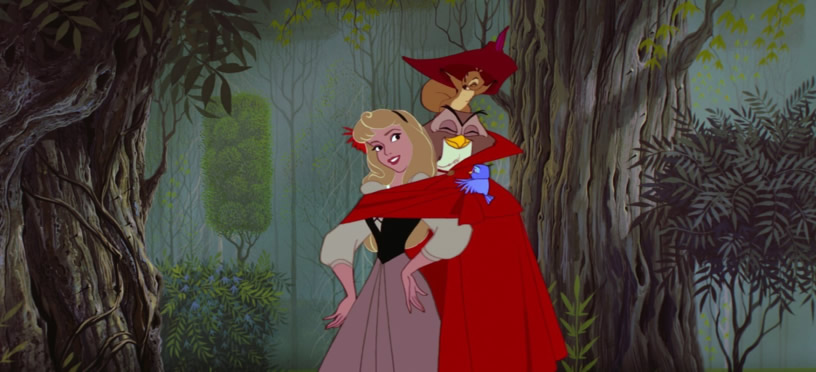
(Apart from that the movie is interesting in other ways, and Angelina Jolie is stunning as usual)
And here’s the beautiful song « Once Upon a Dream » by Lana del Rey, with excerpts from both movies:
We don’t see many women game designers in fiction. So I was really surprised when I discovered Amy in Spike Jonze’s Her, and happy to see that female game designers become something real even outside the game industry. I immediately liked her. And I tried to remember if I had ever seen another character like her. I could only think of Allegra in Cronenberg’s eXistenZ. These two characters seem totally different, one is built of so many fantasies and the other of many little truths… But they share the same uncertainty about identity, power and relationships. And I feel that the fact that they are both game designers AND women brings a lot to the stories.
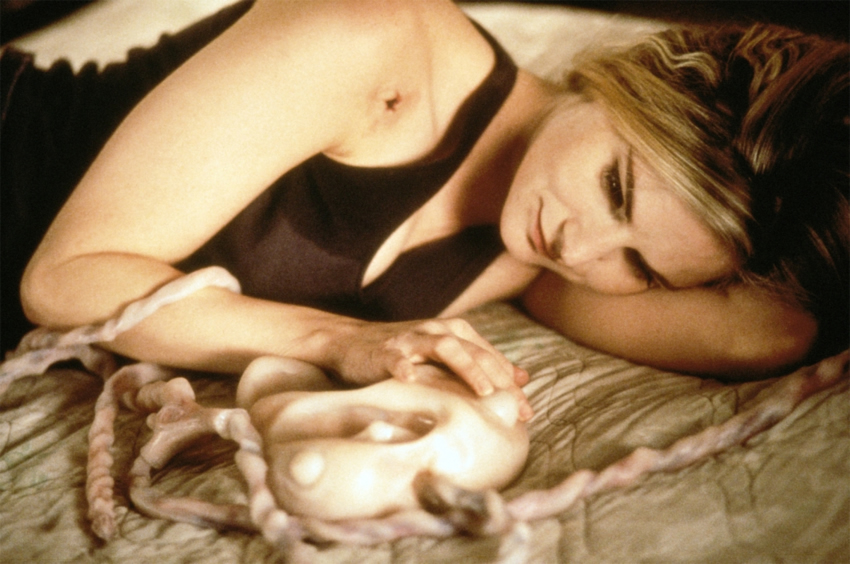
Allegra Geller is « the best game designer in the world », if such a distinction means anything at all. She’s an avant-gardist genius, and her work is worth industrial espionage, conspiracies and attempted murder.
Her games use organic devices that require to be plugged directly into the player’s body, through a “bioport”.
When she connects herself to the device, it’s showed as something weirdly erotic and sensual. Allegra seems somehow addicted to the feeling, and physically attracted to the device. She also uses Jude Law’s character in her pre-game foreplay, but only if he accepts to get this additional hole in his body.
Everything related to these gaming devices is organic, feels like skin or bones, everything seems a little dirty, wet and sticky. The bioports can even be infected and transmit diseases from within the game. The machine becomes half-human while the Humans accept to lose part of their free-will when they’re in the game, playing a scripted scenario through their avatars.
Playing a game seems to be something morbid, weird, a little disgusting, fascinating, a fetishist exploration of the twilight zone where life and death, real and virtual overlap, where bodies and toys are the same, where you accept to lose control and become someone else’s thing, or where you’re the one designing reality for the others.
I feel that Allegra being a woman allowed Cronenberg to push this almost sexual player/designer relation to the extreme, looking for the thrilling moment when you’re not sure if you’re playing or if you’re being played with. Something we are yet to experience in virtual reality games.
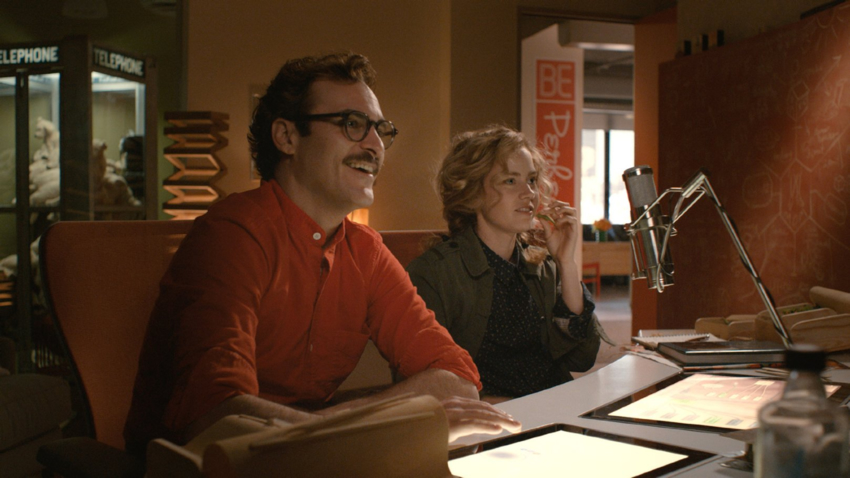
Amy is nothing like Allegra. She’s not famous, she’s not a game design genius. She’s just a simple designer working for a company that makes casual games “for women”. We can see her explaining the game concept to Theodore: you play as a woman who must become the perfect mother. You have to feed the kids the right breakfast, and drive them to school before everybody else… If you fail, you lose points and are a bad mother. It feels exactly like so many real time management games, Dinner Dash and the likes.
Amy has nothing to do with her game’s character: she’s not a mother, she doesn’t wear pretty dresses, and above all she doesn’t want anybody to expect her to behave in a specific “perfect” way. That’s the reason why she decides to suddenly end her marriage.
She doesn’t really enjoy the games she has to make, but that’s a living, isn’t it? She dreams of becoming a documentary filmmaker, but she’s too shy to show anybody her first attempts.
In one of her documentary projects, she filmed her own mother while she was sleeping. Amy explains vaguely that we spend a third of our lives asleep, and that maybe it’s the only moment when we really feel free. Quite the opposite of the hyperactive mom in the race for perfection.
Amy jokes about the game, and reveals she has snuck some secret actions in it, like the perfect mother masturbating against the perfect kitchen’s fridge.
I really could relate to Amy’s character: not knowing exactly what you want but being sure you don’t want anybody to tell you, having something to say but looking for the right means to express it…
I liked seeing her at her desk, explaining the game mechanics in front of a big brown board covered in flowcharts and notes. I liked seeing her joking on this stupid perfect clichéd woman she has to make a game about, and the real, lonely, doubtful woman that she is herself.
A reminder that society is a shape-fitting game, and that sometimes you’re not sure if you fit anywhere. You have to deal with rules and constraints, and cheat a little when you need some air, or even retreat in sleep or in a « virtual » friendship with an AI. But what keeps you going is this idea that sometimes you get to be the game designer, and create your own rules, your own world, and your own way to play.
I hope to see more fictional women game designers in the future, as there are more of us each day in real life.
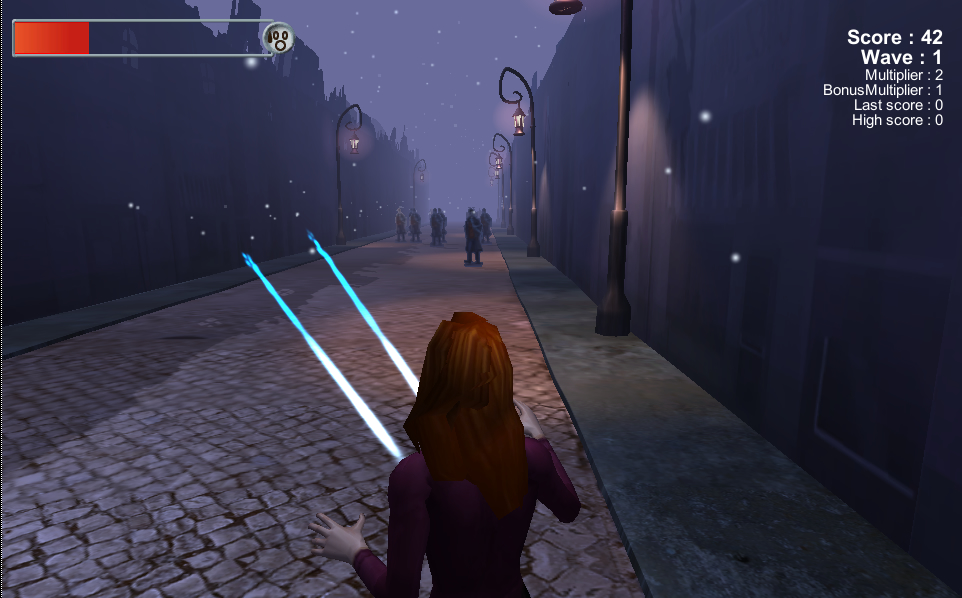
This game was made for the « Boob Jam », read here what it is all about.
Our submission is an anti-3rd person shooter, as you must avoid shooting people with your laser-boobs. Also it’s something of a personal autobiography about having boobs.
You can play the game here.
We weren’t able to add some subtitles, so here’s the script:
When I was, maybe, 14, I was walking along the street, it was a little cold, and I guess my nipples were a little pointy. And that guy asked me if I wanted to have a cup of coffee with him. I politely declined with a smile… and then he saw my braces. Ha-ha! He barely said goodbye. Sucker.
Can you imagine if there were braces for boobs? A metallic contraption that would pull on your boobs all day to make them grow bigger or higher? Teenage girls walking around with exoskeletons under their shirts.
—–
I remember my first bra. It was white with little green flowers, like Scarlett O’Hara’s picnic dress. I was so proud I told everybody about it. My grandpa wrote me back “That’s cool but what on Earth do you put in this bra? Socks?” I didn’t understand what he meant. But my little sister, actually, she used to put socks in her pants, because she wanted a nice bulge, like boys have. She found that pretty. I never put socks in my bra. Scarlett O’Hara wouldn’t do that.
—–
When my boobs first started to grow, it was really painful. At the time I was so shy that I used to sleep with my back turned to the world, my face in the pillow. But I couldn’t lie on my boobs anymore, it was hurting so much! I was desperate. I thought I wouldn’t ever sleep again in my entire life. I thought I’d be forced to lie on my back and that whatever was hiding in the dark would devour me, starting with those stupid boobs.
—–
When I was in junior high, there was this boy who would always pinch my boobs whenever he passed by me. I was so scared I’d never say anything, just blush and try not to cry. But one day I decided I had enough and I clumsily slapped him back. Everyone around laughed. He was so surprised that he asked me out. Asshole.
—–
When I was a kid my mother took me to a joke shop and said I could pick one thing for my birthday. I went to the disguise department and chose a pair of fake plastic boobs. My hippie Mom said it was ok to be curious about boobs at my age… and she bought them. Thinking about it, maybe this was one of the reasons my friends’ mothers stopped them from playing with me.
—–
As a teenager I still had quite small boobs, so I didn’t bother to wear a bra anymore. But there was a trend among boys where they used to try and grab a girl’s bra in their back and make it slap. And of course if a girl didn’t wear any bra they would tell everybody. So in the school cafeteria I would always sit with my back to the wall, like a cowboy in a saloon.
—–
One day in high school I was wearing a large white shirt, musketeer-style. Apparently you could peek between the buttons because one of my friends wrote me a love poem about the nipple he had glanced at. He wrote me a fucking poem. Because he had seen my nipple. Seriously. I think that’s the day I started to wear a bra every day.
—–
It took time before my boobs became boob-shaped. At first they didn’t have much weight and they looked like weird pointed hats. I remember a sleepover with my friends, we were maybe thirteen. In the middle of the night we were playing an invented game, a mix of strip-poker and “Truth or Dare”. Our favourite “Dare” was “Show your boobs for one second”. Hey, what better way to check you’re normal compared to your classmates! Pointed hats everywhere.
—–
It’s funny how pointy boobs were in fashion in the 50s. The bras really shaped them like cones. Nowadays, your boobs need to be round like balls, without visible nipples.
Your underwear really shapes your boobs. I wonder what shape will be fashion in the future, when robots rule the world. Square boobs maybe?
Well, growing some boobs is not simple. You have to get used to them. Anyway one thing I’d really love to have in the future is laser boobs. Shooting at things and people with your boobs. Aiming with your nipples. That would be pretty cool.
|
|








